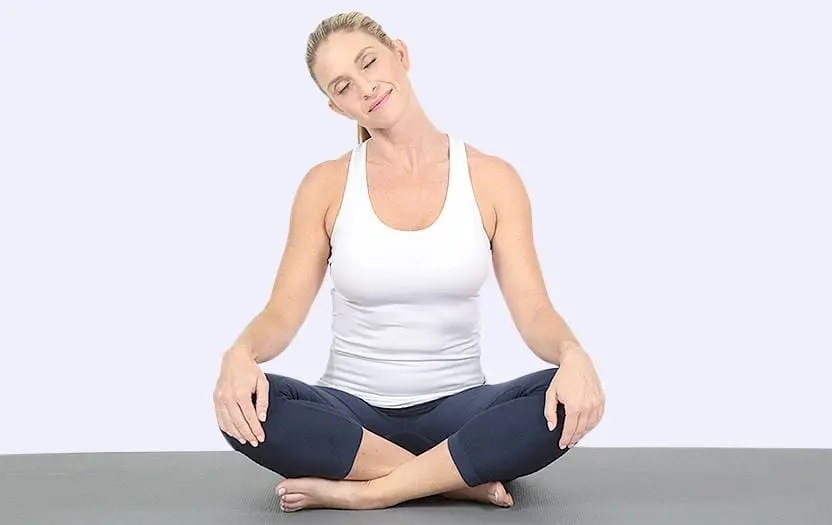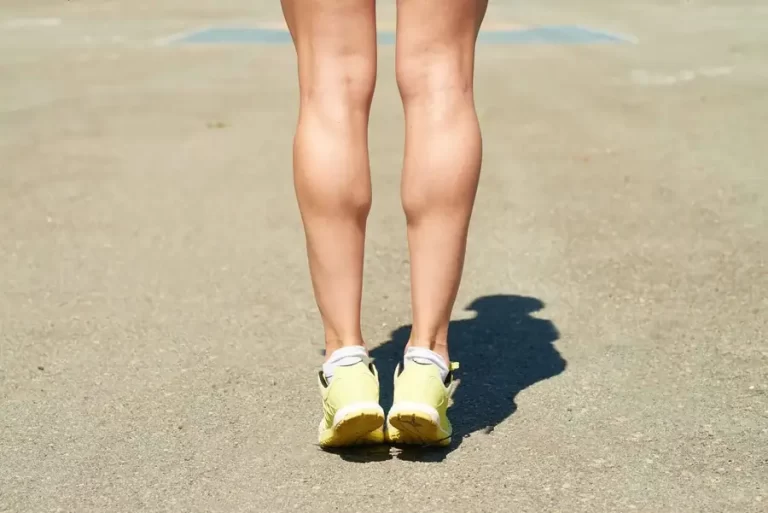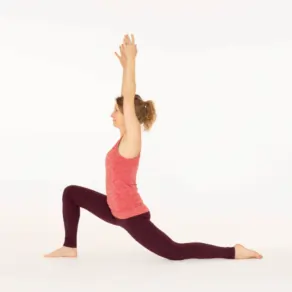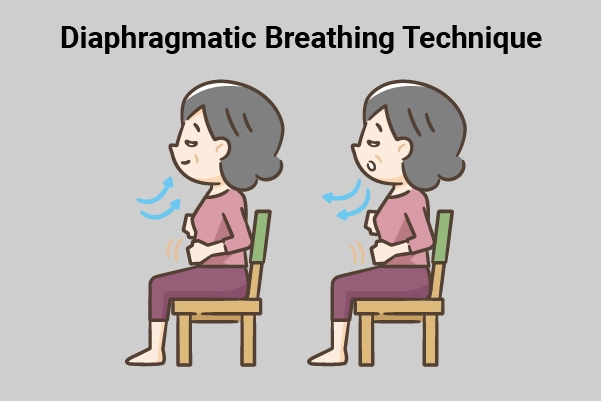13 Best Exercises For Text Neck Pain
Introduction:
Text Neck Exercises are an essential part of your overall treatment plan, in addition to medications, physical therapy, and ergonomics.
One term for a specific type of neck pain that is becoming more common due to our excessive smartphone use is “text neck. A restricted range of motion, pain, and stiffness may be the outcome of this strain. Additionally, due to the amount of time younger people spend on their smartphones, it is becoming more prevalent in them.
When utilizing mobile gadgets, such as telephones, keep a better posture. Make regular exercise a habit. Youth who play power or low-impact team sports may be less likely to experience neck problems.
The Advantageous:
- Increases the effectiveness of daily exercise
- Improve your balance and your posture.
- Relaxing the Muscles
- lessens pain
- Become more flexible.
- This helps it to strengthen its weak muscles.
- Release any tightness or tension.
- You can regain your mobility with exercise.
Exercises For Text Neck:
While it might not be possible to stop staring down at your phone entirely, you may reduce some of the strain on your neck and back by doing certain exercises.
The best exercises for text neck are as follows;
Doorway Stretch
- When standing in an open doorway or corner, as advised, lift both arms to the side, elbows at a 90-degree angle, and face front.
- Put your hands and forearms on either side of the doorframe to feel the stretch in your shoulders and chest.
- Then move forward with a gradual, one-footed step.
- Hold this posture for a few seconds.
- Then return to your neutral position.
- Then relax.
- Repeat this exercise five to ten times.

Chin Tucks
Chin tucks help to realign the movements that take place when you bend your neck forward to gaze at a screen. By moving the head closer to a neutral stance with the ears directly over the shoulders, chin tucks will help with posture.
- Start by fixing your gaze at a particular spot across the room while sitting or standing straight.
- To help you with your motions, rest your index finger on your chin.
- Just slightly move your head horizontally and press your chin up against your neck.
- Your head should not bend downward to stare at your toes due to the movement; instead, it should cause a double chin as you keep your eyes forward.
- Hold this posture for a few seconds.
- Then return to your neutral position.
- Then relax.
- Repeat this exercise five to ten times.
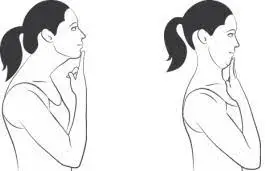
Prone scapula squeeze
With this exercise, your chest will open up and some of your shoulder blade muscles will become active.
- Start by lying on the bed with your stomach up.
- Put a little piece of rolled towel under your forehead.
- Keep your arms by your sides with your palms facing inside.
- Put pressure on your shoulder blades.
- During this process, you might feel your shoulders lift off the bed.
- Hold this posture for a few seconds.
- Then return to your neutral position.
- Then relax.
- Repeat this exercise five to ten times.
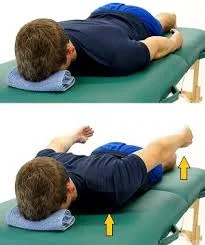
Quadruped Thoracic Rotation Stretch
- Start from all fours, placing your hands beneath your shoulders and your knees below your hips.
- As you engage your core, maintain a straight back.
- Put your left hand on the back of your head with your elbow pointing to the left.
- Don’t apply any pressure on your head or neck; just gently rest the hand.
- This is the initial position.
- Slowly turn your head and shoulders to face the place where your right hand is on the ground.
- Next, turn to the left and up while repeating the action so that your elbow is pointing upward.
- Hold this position for a few seconds.
- Then return to your neutral position.
- Then relax.
- Repeat this exercise five to ten times.
- Repeat the same movement opposite site.
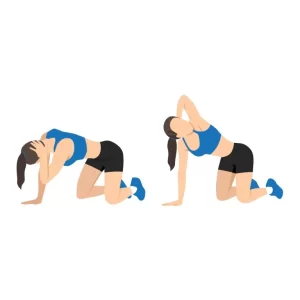
Trapezius stretch
This exercise helps the release of tension in the trapezius muscles, which run the length of the neck and shoulders and are involved in neck extension and shoulder blade rotation.
- Avoid raising your left shoulder and keep your left hand on your chair beneath your leg while you concentrate straight ahead.
- Lean your right ear toward your right shoulder, lift your arm to the right, and cover your head with your hand.
- While you tilt your head to the right, keep your left shoulder from lifting.
- Hold this posture for a few seconds.
- Then return to your neutral position.
- Then relax.
- Repeat this exercise five to ten times.

Shoulder Scapular Squeeze
- Begin in a relaxed standing position on the ground.
- Now squeeze your shoulder blades.
- Maintaining your forward gaze, lift your shoulders away from your ears, and lower your head and shoulders backward to increase the intensity of the stretch.
- Hold this position for a few seconds.
- Then slowly release.
- Then return to your neutral position.
- Then relax.
- Repeat this exercise five to ten times.
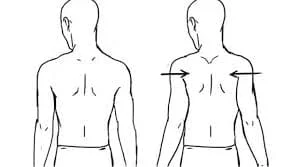
Thoracic extension
This exercise helps to mobilize the joints of your upper back.
- First, settle into an ergonomic chair.
- With your arms extended above your head, put your hands behind your head with your fingers securely grasped.
- With your back straight, gently bend in your chair so your stomach is lowered toward your thighs.
- Stomach close to thighs elbows up, and head tilted to gaze toward the horizon, all while bending your upper back.
- Hold this posture for a few seconds.
- Then return to your neutral position.
- Then relax.
- Repeat this exercise five to ten times.
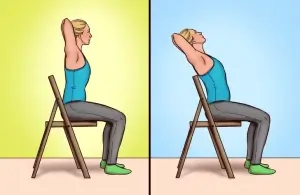
Reverse Shoulder Stretch
- Start with your fingers joined behind your butt as you stand upright.
- Push your arms up until you feel a stretch in your pecs while maintaining a straight back and shoulder blades together.
- Hold this posture for a few seconds.
- Then return to your neutral position.
- Then relax.
- Repeat this exercise five to ten times.
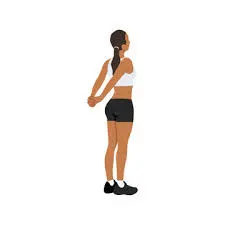
Sphinx Pose
- Lying on your stomach, extend your legs straight out behind you.
- Keeping your forearms on the ground and your elbows beneath your shoulders, elevate your body off the floor.
- Try to stretch your spine while maintaining a relaxed posture and pressing your hips and thighs into the floor.
- To provide a comfortable and extended lower back, raise the body.
- Refrain from pushing yourself too far, and stop immediately if you feel any pain or discomfort.
- Hold this posture for a few seconds.
- Then return to your neutral position.
- Then relax.
- Repeat this exercise five to ten times.
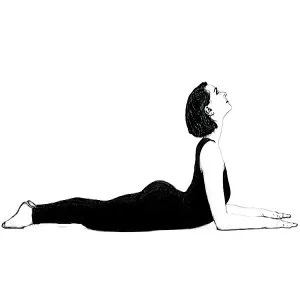
Levator scapulae stretch
The levator scapulae is a further neck muscle that may become tense with the text neck. Your neck and shoulder blades are connected by this muscle. You can reduce stress by performing this levator scapulae stretch.
- Take a seating position on the table.
- Putting your right hand around your head is good.
- Raise your head at a 45-degree angle to the right.
- Make a significant movement with your head down toward your right armpit, letting your left side of the neck extend.
- Hold this posture for a few seconds.
- Then return to your neutral position.
- Then relax.
- Repeat this exercise five to ten times.
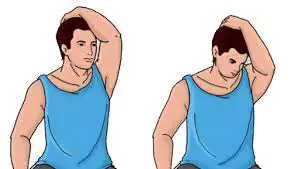
Cat-Cow
- Start by placing your hands and knees on the ground in the tabletop position.
- Keep your back straight.
- Hold both of your feet and hands on the ground.
- Open your eyes, inhale, and allow some air to enter your stomach.
- Hold this posture for a few seconds.
- Pull your chin into your chest and let go of the air while facing the ceiling.
- Your lower back seems to be slightly stretched.
- Hold this posture for a few seconds.
- Then return to your neutral position.
- Then relax.
- Repeat this exercise five to ten times.

Neck roll
- Sit in a comfortable position to start.
- Until you feel your neck muscles lengthening slightly, turn your head to the right.
- In a few seconds, turn your head clockwise.
- Hold for a few seconds until you’ve reached your left shoulder side.
- Your neck muscles ought to feel somewhat stretched once again.
- Finish the rotation in a clockwise manner.
- Then return to your neutral position.
- Then relax.
- Repeat this exercise five to ten times.
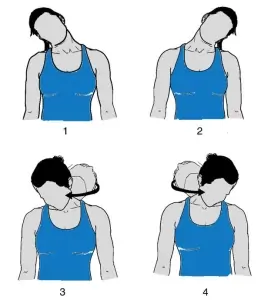
Side Bending Neck Stretch
- Keep your back to the chair and your feet flat.
- You can stabilize your right arm by holding onto the chair’s edge or by sitting on your hand.
- Gazing straight ahead, move your left ear to your left shoulder.
- You might use your left hand to gradually deepen the stretch.
- Hold this posture for a few seconds.
- Then return to your neutral position.
- Then relax.
- Repeat this exercise five to ten times.
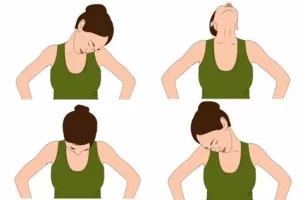
When exercising, what safety measures need to be followed?
- Stretch and warm up gently before working out.
- When exercising, keep your posture correct.
- Refrain from overdoing yourself.
- If you get sudden pain when exercising, stop.
- In between exercise sessions, take a rest.
- Staying hydrated.
- Bend and stretch your neck a little.
- Avoid jerky movements close to your neck’s base.
Why do you not exercise?
- Muscle pain that feels like burning
- You don’t feel well.
- If you feel any pain or numbness.
- Headache
- Fever
- If working out hurts, stop.
Which exercises or activities are best avoided if you have a text neck?
- Make sure you’re sitting in the right posture if you spend a lot of time on your phone or computer.
- Limit the amount of time you spend using the apps or looking at your phone’s screen.
- To cut down on the amount of time you spend looking down, you may also get a phone or tablet stand that angles the screen in your direction.
- Avoid sit-ups as they place a lot of strain on your cervical spine.
- Avoid crunches as they put too much tension on your neck.
Summary:
The term “text neck” describes a particular kind of neck pain that has increased in frequency due to how much we rely on technology. It results from the tension that staring down at our phones and tablets for extended periods puts on our necks.
The pressure may cause pain, stiffness, or even a limited range of motion. Because of how much time younger generations spend on their devices, it’s becoming more and more common among them.
You may improve your posture with various neck exercises that strengthen and stretch your tight, weak muscles. Neck pain can be avoided by limiting the amount of time you spend in front of a screen and being mindful of your posture when using electronic devices.
FAQ:
Where is the text neck the most apparent?
The prolonged forward head posture that causes “text neck syndrome” is a cause of neck harm. The cervical spine’s curvature, the shoulder and neck muscles, and the supporting ligaments are all affected by the forward-leaning posture.
How often should someone engage in text neck exercises?
Exercises for text neck pain can be done for at least 30 to 35 minutes a day. You can help yourself feel better by following a basic daily routine of stretching and exercise.
What is the best course to take for treating text neck?
Treatments for text neck injuries often include rest, physical therapy, stretching exercises, and correcting bad posture habits. By doing these exercises, you can ease the strain put on by poor posture and strengthen the muscles in your neck and upper back.
How long does neck pain last?
Usually, acute neck pain goes away in one to two weeks. Some people return to it following a demanding workday or after engaging in physical activity. It is considered chronic when neck pain develops for more than three months.
Can I still work out if I have neck pain?
Your neck pain shouldn’t get worse during exercise. A common side effect of the body adjusting to new movements is muscle pain. This kind of soreness should pass quickly, and after you’ve worked out the next morning, it shouldn’t hurt any worse.
Is it possible to avoid text neck?
Bring the phone (and other electronics) closer to eye level to prevent forward head tilt. Take frequent pauses. Take a short break from using your phone or taking any other forward-facing position. When it’s essential, set an alarm or an app to remind you to take breaks from your mobile devices.
What term describes most effectively text neck syndrome?
The term “text neck syndrome,” also known as “tech neck” or “smartphone neck,” was first used relatively recently to characterize the neck strain and injury caused by prolonged looking at electronic gadgets.
Can headaches result from text neck?
Headaches and mid- and lower-back pain can result from excess spinal pressure in the neck. Your spine’s discs shorten with aging, and some of their supporting capacity is lost.
How can someone with a text neck sleep?
Although side sleeping is equally beneficial, lying on your back maintains the most neutral position for your spine. Make sure to place a pillow between your knees to support your pelvis if you decide to sleep on your side. Examine the kind of pillow you use to support your head as well.
Does text neck lead to harm to nerves?
Muscle stiffness, joint inflammation, pinched nerves, arthritis, bone spurs, and herniated discs can all be the result of the repetitive strain that staring down at a screen puts on the bones, nerves, and muscles.
Is neck pain caused by poor posture?
Pain in the neck is frequent. Neck muscles are strained by bad posture, which might result from stooping over a workbench or bending over a computer. Rarely, neck pain could be a sign of a more serious problem.
Text neck pain: where is it located?
Text neck is usually caused by a strained muscle on the side or back of the neck, where the tendons and muscle fibers may be pulled or stretched beyond normal limits. If a large muscle, like the trapezius, is stretched, neck pain may radiate down the shoulder, over the shoulder blade, and across the upper back.
What factors put one at risk for text neck syndrome?
The primary cause of this health condition’s worsening is prolonged downward gaze with the cervical spine in flexion, such as when using smartphone or tablet devices, reading on a laptop, or lowering the head forward to view a computer screen.
Is it better for the text neck to be cold or warm?
For the first 48 to 72 hours, use ice, and then switch to heat to help alleviate stiffness caused by tech neck. Apply heat to the affected area to reduce pain and stiffness. Alternately, you can apply a heated cloth soaked in hot water to your neck, use a heating pad, or have a hot shower.
References:
- D. Bariya (2023g, Dec. 13). The Top 25 Exercises for Treating Text Neck Pain (Mobile Physio). Mobile Clinic for Physiotherapy. Here are the top 25 exercises to relieve text-related neck pain: https://mobilephysiotherapyclinic.in/
- 2020 May 30; Kassel, G. 6 Chiropractor-Approved Exercises to Fight Text Neck. Healthline. https://www.healthline.com/health/text-neck-treatment/fitness-exercise
- T. Campbell (2023b), May 19. Five Physio-Recommended Exercises for Preventing Text Neck. Physiotherapy & Sports Medicine for All Sports. You can find the article “The Way to Avoid Text Neck: 5 Physio-Recommended Exercises” here.
- On August 16, 2022, Ryt, E. M. C., and CPT, C. S. Ten Technical Neck Exercises to Reduce Stress and Increase Upper-Body Flexibility. SELF. Tech-neck exercises: https://www.self.com/gallery
- Image 7, Picture 7: Five amazing workouts to help maintain a healthy spine. (2023, September 13). Bright Side — Inspiration. Creativity. Wonder. https://brightside.me/articles/partially-converted-do-not-publish-seven-fantastic-exercises-to-give-you-a-healthy-spine-11505/

